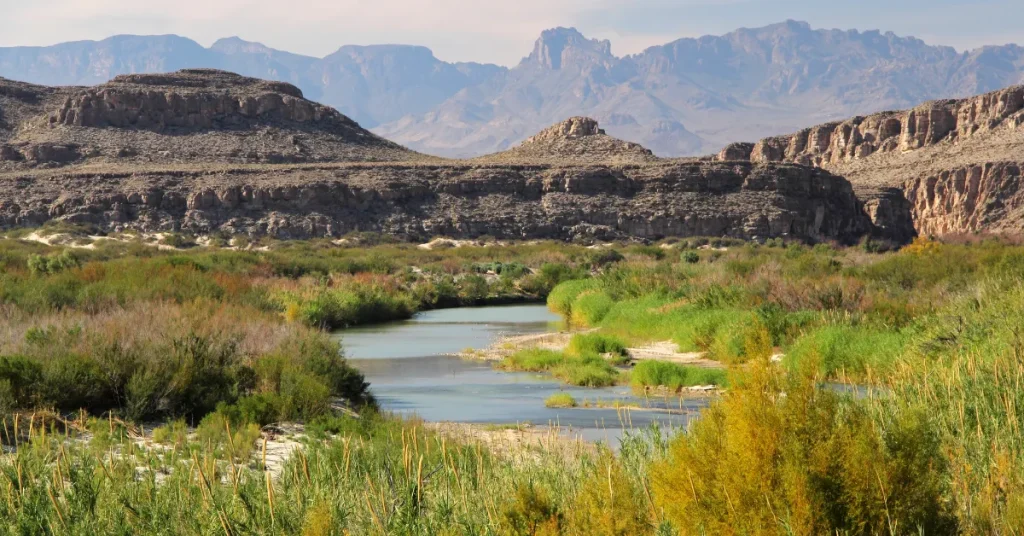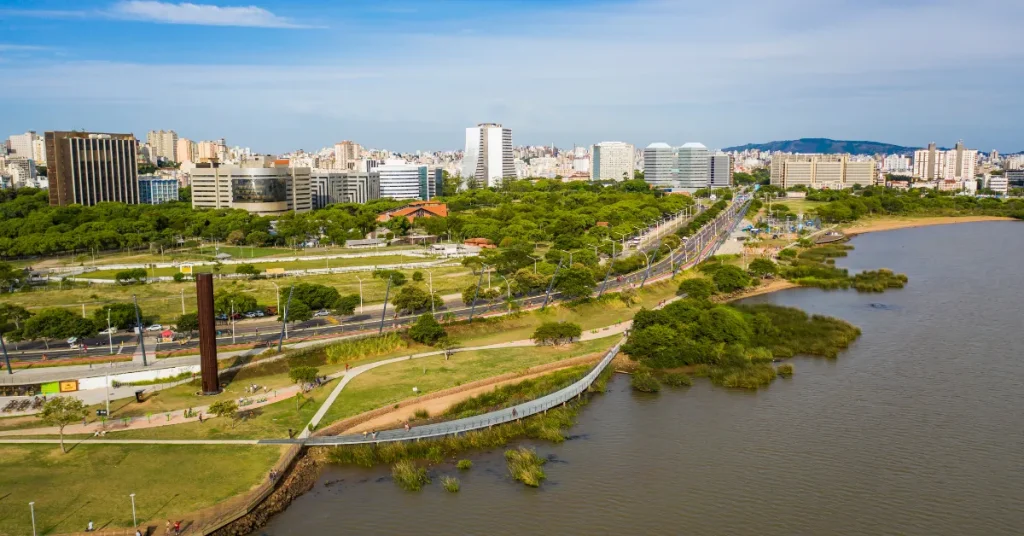The Rio Grande varies in width from 50 to 200 feet. It can expand to several miles across during floods.
The Rio Grande, a vital water resource and natural boundary, stretches over 1,900 miles, forming part of the U. S. -Mexico border.
Originating in the San Juan Mountains of Colorado, it flows through New Mexico before reaching Texas and serving as the international border.
Over time, the river has been a witness to history, from Spanish conquests to modern immigration issues. It provides essential irrigation for agriculture and is a focal point for conservation efforts.
Significantly, the river’s width is not just a geographical statistic—it reflects a dynamic ecosystem that influences the lives and politics of two neighboring nations.
The Rio Grande supports diverse wildlife and is crucial for the cultural heritage and economies of the border regions.

The Rio Grande’s Meandering Path
The Rio Grande’s Meandering Path tells a story of natural wonder. This grand river shapes the land it traverses, offering a blend of habitats and rich history along its course.
Traveling from snowy peaks to the warmth of the Gulf of Mexico, the Rio Grande’s width varies dramatically. Its journey is a constant dance with geography, winding through vast landscapes that define its breadth.
Origin And Course
The Rio Grande begins its life in the heart of the Colorado Rocky Mountains. From there, it flows over 1,900 miles until reaching the Gulf. Along this path, it serves as a natural border between Texas and Mexico, intertwining the destinies of two nations.
- Source: San Juan Mountains, Colorado
- Length: Approximately 1,900 miles
- Exit: Gulf of Mexico
Geographical Influence On Width
The Rio Grande’s width is not constant. Geography plays a key part in how broad the river gets. In canyon areas, it’s often narrower and deeper. Flatter regions allow it to stretch out and become wider.
| Location | Average Width |
| Rio Grande Gorge | 20 to 30 feet |
| Floodplain Areas | Up to several miles |
During times of heavy rainfall or snowmelt, the river can swell even further, altering the landscape and affecting its ecosystems. The width of this mighty river is a testament to the dynamic forces of nature and the landscapes it carves.
Measuring River Width

The Rio Grande, a river steeped in history, snakes through varied terrains, offering a glimpse into its dynamic span.
Determining the exact width of this impressive river involves techniques ranging from traditional to modern. These methods cater to the needs of geographers, cartographers, and environmental scientists alike.
Traditional Methods
Historically, measuring a river’s width was a hands-on process. It typically included physical tools such as:
- Ropes or chains: Extended across the river at designated measuring points.
- Boats: Used to traverse the river while towing measurement lines.
- Measuring tapes: Deployed for smaller river sections.
Surveyors would physically enter the water or use the riverside as a vantage point. These techniques required extensive manpower and time, and they posed challenges, especially with wide rivers like the Rio Grande.
Modern Techniques
Advancements in technology have revolutionized the measuring process. Modern techniques include:
- GIS mapping: Geographic Information System (GIS) tools provide detailed and accurate river dimensions.
- Satellite imagery: Offers a bird’s-eye view of the river, enabling precise width measurements.
- RADAR/LiDAR technology: Utilizes radio or light waves to map the boundaries of the Rio Grande.
These cutting-edge methods lessen human error and provide comprehensive data, crucial for resource management and scientific research.
The digital era allows for continual monitoring of the Rio Grande, revealing changes over time and aiding in effective decision-making.
Factors Affecting The Rio Grande’s Breadth
The Rio Grande is a living entity; its width is not constant. Various factors influence its breadth. Understanding these elements offers insight into the river’s dynamic nature. This section of our blog post delves into the primary factors that affect the Rio Grande’s width.
Seasonal Variability
Seasons reshape the Rio Grande. Shifts in precipitation and temperature throughout the year naturally affect its size.
The breadth of the Rio Grande expands with the spring thaw and rain, often reaching its peak during this period. In contrast, the dry conditions of summer and fall lead to a narrower river.
- Increased flow in spring from snowmelt and rain
- Summer shrinkage due to reduced rainfall and higher evaporation
- Autumn and winter bring lower water levels
Human Impact On River Dynamics
Human activities significantly alter the Rio Grande’s traditional flow patterns. Dams, irrigation, and water diversion projects modify its course and breadth. Cities along the river consume vast amounts of water for various purposes, impacting the river’s size.
| Action | Effect on Width |
| Dams | Restrict flow, narrowing river downstream |
| Irrigation | Diverts water, reducing river’s size |
| Urban Consumption | Decreases volume, shrinks river’s breadth |
Environmental regulations strive to mitigate these impacts, but the river’s width remains a sensitive indicator of both the natural world and human influence.
The Rio Grande By The Numbers

The Rio Grande carves its path through stunning landscapes. It ties borders and cultures, but by what measures? Let’s unfold the statistics of this mighty river, exploring its most remarkable physical dimensions.
Narrowest And Broadest Points
The Rio Grande varies widely across its journey. At its narrowest, it shrinks to under 18 feet in Big Bend National Park.
Unlike its slender stretches, the river reaches its maximum width near the opening of the Gulf of Mexico, with a broad expanse of nearly two miles.
Comparisons With Other Rivers
- Mississippi River: Typically spanning about a mile at its widest, the Rio Grande surpasses this breadth as it approaches the ocean.
- Amazon River: With mind-boggling widths exceeding 6 miles during wet seasons, the Amazon dwarfs our Rio Grande’s expanse.
- Thames River: In little old England, the Thames’ maximum width stretches roughly 870 feet, a meager figure next to Rio Grande’s mightiest points.
Among neighbors and giants, the Rio Grande holds its own with a size that supports diverse ecosystems and human endeavors.
Conservation And The Future Of The Rio Grande
The Rio Grande, known for its vast expanse and cultural significance, faces uncertain times. Sustainable practices and focused conservation efforts become pivotal for its survival.
The river’s health and natural width are under threat due to various environmental and human-induced factors. Protecting this precious resource demands immediate attention.
Here, we outline the dedicated efforts to conserve the Rio Grande and the challenges in maintaining its width for future generations.
Efforts To Protect The River’s Health
- Restoration Projects: Local groups plant trees and vegetation near the riverbanks.
- Water Quality Initiatives: Authorities regularly monitor and clean the water.
- Wildlife Protection: Programs preserve habitats for native species.
- Education Campaigns: Communities learn about the river’s importance and how to care for it.
Challenges In Maintaining Natural Width
Preserving the Rio Grande’s width involves overcoming numerous hurdles:
| Challenge | Impact on River Width |
| Climate Change | Droughts shrink the river’s flow and width. |
| Urbanization | Construction near banks leads to erosion and width reduction. |
| Overuse of Resources | Excessive water withdrawal for agriculture and industry affects the river’s size. |
| Dams and Diversions | Water flow control can constrict the river’s natural spread. |
Effective strategies must address these challenges to preserve the Rio Grande’s legacy for future enjoyment and ecological balance.
FAQs About How Wide Is The Rio Grande
How Deep And Wide Is The Rio Grande River?
The Rio Grande varies in depth and width across its length. On average, it measures about 3 feet deep and up to 200 feet wide.
Can You Walk Across The Rio Grande?
Yes, you can walk across parts of the Rio Grande, especially during periods of low water level, but always remain mindful of the legal and safety implications.
What Is The Widest River In Mexico?
The widest river in Mexico is the Grijalva River, spanning an impressive width as it courses through the country’s landscape.
How Much Of The Us Mexico Border Is The Rio Grande?
Approximately 1,254 miles of the U. S. -Mexico border is defined by the Rio Grande River. This spans from El Paso, Texas, to the Gulf of Mexico.
Conclusion
Exploring the Rio Grande reveals a river of shifting breadth, a symbol of natural diversity. From narrow gorges to wide valleys, its span fluctuates dramatically.
This journey underscores the river’s majesty, an ever-changing wonder that shapes landscapes and stories alike.
Embrace its dynamic width, a testament to nature’s complexity.
Resources:
1. https://www.nps.gov/bibe/learn/nature/riogrand.htm
